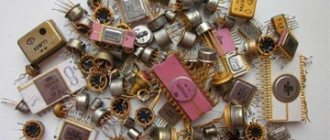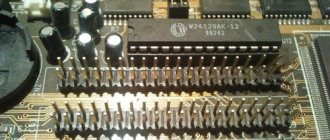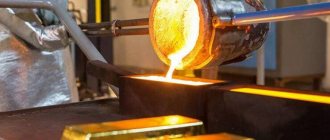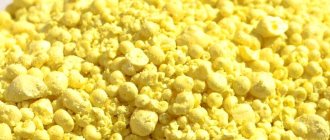Refining is the purification of metal from impurities.
This process consists of a series of sequential processes for separating excess components by physical and chemical means.
Some of the refining methods used in industry can be implemented at home, but sometimes the costs of carrying out the reactions exceed the profit from the resulting noble metal.
In this article we will tell you how to remove and separate gold from radio components and get it out of microcircuits, how to do it safely with your own hands.
Where is this precious metal found?
Hundreds of tons of gold are used annually in the production of radio components and computer chips. Contacts made of this metal are characterized by high electrical conductivity, they are not subject to oxidation, and therefore are widely used.
Gold
is contained in the following components :
- diodes;
- transistors;
- glass electrodes;
- relay;
- ports;
- jumpers;
- motherboard memory modules.
Note that in practice there may be much less gold in radio components than there should be according to documents (especially in technical products made after 1989).
Methods for removing impurities
The main method of isolating pure metal from mixtures, including from various radio components, is chemical refining . It is very common to dissolve it in aqua regia (a mixture of nitric and hydrochloric acid), followed by passing through a filter and reduction.
Electrolysis method
With the electrolysis method, gold from radio components or any other gold exposed to sulfuric or hydrochloric acid is deposited on the cathode when an electric current passes through the solution.
In industry, a cathode made of already purified gold is used; at home, you can use iron or lead .
A drop in current is a signal that the dissolution process is complete. This method is also effective and therefore quite common.
Cleansing with iodine
To etch gold from the surface of radio components, the most common pharmaceutical Lugol's solution is used - it is a mixture of iodine and potassium iodide. During the reaction, complex anions containing gold molecules are formed.
To increase speed, chemists add sulfuric or nitric acid . The dissolution process can continue for days. Subsequently, the noble metal is precipitated from the solution in different ways.
Using bleach "Whiteness"
Popular household bleach consists primarily of sodium hypochloride.
This substance, when mixed with hydrochloric acid, produces chlorine , which is subsequently used to dissolve gold to form gold chloride.
After this, sodium bisulfate is added .
At the end of the reaction, gray particles remain at the bottom of the vessel - this is gold, which will acquire a natural color after remelting.
Another option is to mix White, table salt (sodium chloride) and battery electrolyte, which is nothing more than sulfuric acid. The hypochlorous acid obtained during the reaction dissolves gold - it must be reduced in the future .
Refining "without acid"
Recipes spread on the Internet for obtaining gold from radio components and dissolving gold “without acid” essentially mislead readers, since acid (usually hydrochloric acid) is formed as a result of the reaction of other substances .
In addition, not everyone knows that the battery electrolyte used in such cases is also an acid.
Using Hydrogen Peroxide
The extraction of gold from radio components using hydrogen peroxide is carried out as follows.
This substance, otherwise called perhydrol, reacts with hydrochloric acid, dissolving gold. To do this, gold-containing raw materials are poured with acid and peroxide is added.
The resulting chloroauric acid is further decomposed into elements .
To do this, you can use a thermal method (point a blue flame of a burner at the substance) or a chemical one. The latter consists of reducing gold by adding ferrous sulfate.
Other extraction methods
There are many other refining methods that can be used to collect gold from chips, such as electrolyte and ammonium nitrate.
In this case, the electrolyte is mixed with ammonium nitrate - the so-called salt of nitric acid. The resulting composition is capable of dissolving the noble metal.
Most other methods also based on the dissolution of gold and its subsequent reduction .
The processes differ according to:
- cost;
- availability of components;
- reaction speed.
Recommendations for preparing solutions in the laboratory
We talk about the principles of preparing solutions from solids, alkalis, acids and fixings.
Content
Preparation of solutions:
- from solids
- alkalis and acids
- from fixed channels
Preparation of solutions from solids
The amount of solid that can be dissolved in a given amount of water has a limit depending on the properties of the substances taken and on the conditions under which dissolution occurs. When this limit is reached, a saturated solution is obtained. The concentration of a saturated solution is called solubility.
Consequently, the saturation of a solution with a substance depends on its solubility in a given solvent under given conditions. Thus, it is not at all necessary that the concentration of the saturated solution be high.
The solubility of a solid can be increased by heating the solution. However, some salts do not follow this rule. Their solubility either decreases with increasing temperature or increases only up to a certain temperature, above which solubility decreases. The rate of dissolution of a solid depends on the size of its particles. The larger the pieces, the slower the dissolution; on the contrary, the smaller the individual particles of a solid, the sooner it goes into solution. Therefore, before dissolving a solid, it should always be crushed in a mortar and only the crushed substance should be weighed out for dissolution. The above does not apply to hygroscopic substances, since the latter, when crushed, very easily absorb moisture from the air due to the large increase in surface area. Therefore, hygroscopic substances are dissolved without crushing, unless quickly breaking up large pieces.
Sometimes when solids, such as crystalline substances, are dissolved, they are placed in a flask. If such substances (especially large pieces or crystals) are introduced incorrectly, the flask may break. In order not to break the flask, they do this: tilt it at an angle of no more than 45° (preferably less) and lower the solid substance so that it rolls down the neck and wall of the flask ball. It is more convenient to first pour part of the calculated amount of solvent, such as water, into the flask, and then introduce the solid as described above, occasionally shaking the flask. The remaining part of the solvent is introduced after the entire amount of solid substance intended for dissolution has been poured.
Return to content
Preparation of solutions of alkalis and acids
When alkalis are dissolved in water, strong heating occurs, so to prepare such solutions you should use porcelain rather than glass vessels. The solution is stirred with a glass rod. It is necessary to ensure that splashes of the solution do not get into the eyes, skin or clothing.
Concentrated solutions of alkalis leach glass, so it is better to store these solutions in plastic containers or in a glass bottle, the inner walls of which are pre-coated with paraffin.
When diluting acids, it is necessary to add the acid to the water, and not vice versa. Mixing acid with water is accompanied by strong heating, so when water is added to the acid, the acid splashes, which is very dangerous. If acid gets on your skin or clothing, you must wash it off with plenty of water and then neutralize it with an alkali solution.
1
2
3
4
Rice. 1. Safety precautions when preparing solutions of concentrated acids 1 – do not add water to the acid; 2 – when acid and water are mixed, a large amount of heat is released; 3 – the solution may boil and splash out of the container; 4 – add acid to water with constant stirring.
Acid solutions are stored in tightly closed containers.
Return to content
Preparation of solutions from fixanals
To quickly prepare precise solutions, fixants are used.
Fixanal is a precisely weighed amount of reagent required for the preparation of 1 liter of 0.1 N or 0.01 N solutions, contained in a sealed glass ampoule. The amount of a substance in an ampoule corresponds to a certain number of gram equivalents of a given substance, and when it is dissolved, a solution of known normality is formed. Fixanal can be in the form of a weighed solid substance or in the form of a precisely measured volume of solution.
To prepare a solution from fixanal, the contents of the ampoule are quantitatively transferred into a volumetric flask and the solution is diluted with distilled water, its volume is adjusted to the mark:
1. The ampoule is washed first with warm and then with cold distilled water to wash off the label and possible contamination.
2. Before preparing the solution, one of the strikers (cross-shaped), located in the box with the fixanal, is doused first with tap water and then with distilled water. The firing pin is placed in a clean funnel so that its long end is inserted into the funnel tube, and its short sharp end is directed upward; the cross-shaped thickening of the striker rests on the lower part of the funnel cone.
3. The funnel along with the striker is inserted into a clean volumetric flask.
4. The ampoule is turned upside down and, striking it with its lower recess against the striker in the funnel, the bottom of the ampoule is broken. Without changing the position of the ampoule above the funnel, I pierce the upper recess on it with the second striker. The contents of the ampoule are poured or poured into a volumetric flask.
5. The ampoule is held in the same position and the end of the washing tube is inserted into the formed upper hole and the outer surface of the ampoule and the funnel with the striker are thoroughly washed with a strong stream of water from the washing bottle, after which the funnel is removed from the flask.
6. The liquid level in the flask is brought to the mark. The flask is tightly capped and the solution is thoroughly mixed.
Rice. 2. Transfer the contents of the fixanal ampoule into a volumetric flask 1 – ampoule with an accurate weigh of the substance; 2 – cross-shaped striker; 3 – striker for the ampoule wall.
For more information on methods for preparing solutions using accurate and approximate weighing, calculating the concentration of the resulting solution and setting the titer, read the article “Methods for preparing solutions”
.
Return to content
Source link
Blog “Laboratory_” on Yandex.Zen, article “ Methods of preparing solutions in the laboratory
«.
Step-by-step instructions for extracting metal from radio components and microcircuits
To extract gold from microcircuits and radio components, it is advisable to use aqua regia .
To refine gold using this method, you must perform the following steps :
- grind the components mechanically, separating the parts that contain gold;
- get rid of organic matter by burning or calcining;
- open the windows in the room for better ventilation;
- for experiments, prepare a vessel made of borosilicate glass;
- place the workpieces in a concentrated mixture of 36% hydrochloric acid (3 parts) and 95% nitric acid (1 part) in small portions - up to 3 grams at a time, 500 ml of aqua regia will be required per 100 g of raw materials;
- Heat the solution while gradually adding nitric acid;
- check the presence of gold with tin chloride;
- filter the solution, then remove nitric acid from it.
Gold can subsequently be reduced using ferrous sulfate, perhydrol, oxalic acid or hydrazine sulfate. The resulting gold is smelted into an ingot using a crucible .
Note that it is unsafe to purify gold at home due to the significant causticity and toxicity of the substances used and the volatile compounds released.
In addition, advanced knowledge of chemistry will be required.
Refining gold directly with iodine
This method allows you to refining gold from the found stone. The process itself is quite labor-intensive and does not guarantee success, since the presence of precious metal in a piece of rock is very difficult to determine by eye.
The procedure is as follows:
- the ore is crushed to a homogeneous powder;
- it is washed in a tray until black grains (concentrate) remain;
- the residue is dried and placed in a test tube;
- 10 percent alcohol iodine is also poured in (for 2 grams - 6 ml);
- the mixture is heated for 10 minutes, without allowing it to boil;
- leave until sediment settles;
- the clear solution is collected into a pipette;
- squeeze out drop by drop (as the previous one dries) onto the heated glass.
As a result, if there really was gold in the stone, then a so-called mirror will remain on the plate. It must be washed in nitric acid to remove unnecessary metals. All that remains as a result will be the desired precious metal.
Where to deliver the received material and at what price?
The gold ingot (barrel) obtained as a result of purification most often has insignificant weight. However, even in such quantities it is of interest to buyers.
Advertisements for buying gold can be easily found on the Internet or in local newspapers.
Often, solid metal is purchased by the same companies that buy radio components.
(for example, aluminum or brass) may also be interested in gold
If the buyer is in the same city as the seller, the transaction is completed upon visiting the specified address.
The buyer himself weighs the metal and checks its quality, after which he sets a price. Of course, if possible, it is advisable to check all offers on the market in order to choose the most profitable one. The bullion can be sent to another city by mail, cash on delivery.
Some pawnshops are also ready to accept goods of this kind. To find out at what price the establishment will be willing to purchase gold, contact a pawnshop employee. Another option is to submit an ad yourself . In this case, you just have to wait for a call from a potential buyer.
If you engage in refining on an industrial scale, you should rely on existing laws.
To legally engage in the circulation of precious metals, you need to register as an individual entrepreneur or create an LLC.
When selling gold, focus on its purity and market value.
The price per gram of 999 fine precious metal is set by the Central Bank of Russia . Since 2004, its prices have been continuously rising. The most significant jump was observed in 2021, when the cost exceeded 3 thousand rubles per gram.











